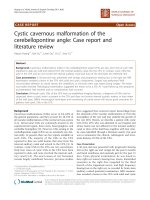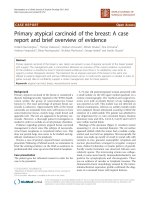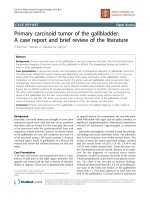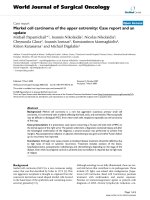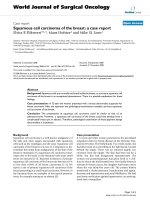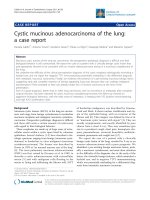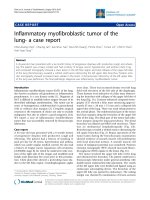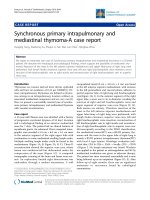Báo cáo y học: "Cystic mucinous adenocarcinoma of the lung: a case report" pot
Bạn đang xem bản rút gọn của tài liệu. Xem và tải ngay bản đầy đủ của tài liệu tại đây (5.33 MB, 5 trang )
CAS E REP O R T Open Access
Cystic mucinous adenocarcinoma of the lung:
a case report
Daniela Cabibi
1*
, Antonio Sciuto
2
, Girolamo Geraci
2
, Chiara Lo Nigro
2
, Giuseppe Modica
2
and Massimo Cajozzo
2
Abstract
Mucinous cystic tumors of the lung are uncommon, the preoperative pathologic diagnosis is difficult and their
biological behavior is still controversial. We report the case of a patient with a clinically benign cystic lesion that
post-operatively showed to be consistent with an invasive adenocarcinoma arising in a mucinous cystadenoma of
the lung,
We underline the difficulty of the clinical pre-operative diagnosis of this cystic neoplasia radiologically mimicking a
hydatid cyst, and we report the negative TTF1 immunostaining potentially misleading in the differential diagnosis
with metastatic mucinous carcinomas. Finallly, we evidence the presence of a pre-existing mucinous benign lesion
suggesting early and complete resection of benign appearing lung cysts because they can undergo malignant
transformation if left untreated or they can already harbor foci of invasive carcinoma at the time of the
presentation.
Even if a good prognosis, better than in other lung carcinomas, with no recurrrence or metastasis after complete
surgical exicision, has been reported for cystic mucinous cystoadenocarcinomas, the follow-up showed an
aggressive biological behaviour, with the early onset of metastasis, in keeping with P53 positive immunostaining
and high Ki-67 proliferation index.
Background
Mucinous cystic tumors (MCTs) of the lung are uncom-
mon and range from benign cystadenoma to borderline
mucinous neoplasia and malignant mucinous cystadeno-
carcinoma. Preoperative pathologic diagnosis is difficult
and there still exists a certain amount of controversy
with regard to their biological behavior.
These neoplasias are made up of large areas of extra-
cellular mucin within a cystic space lined by columnar
epithelium. Several Authors [1-3] have described a his-
tologic spectrum ranging from benign (mucinous cys ta-
denoma) to borderline or clear malignant (mucinous
cystadenocarcinoma) The former was described by
Gower in 1978 a s “an unusual mucous cyst of the lung”
[4]. The term pulmonary mucinous adenocarcinoma
(PMC) was first coined by Devaney et al. in 1989, to
describe a cystic adenocarcinoma with extracellular
mucin [5] and with malignant cells floating in the
mucin or lining and i nfiltrating the fibrous wall. MCT
of borderline malignancy was described by Graeme-
Cook and Mark. It shows nuclear stratification and aty-
pia of the epithelial lining, with no invasion of the
fibrous wall [ 6]. This category was defined by Gao et al.
as “mucinous cystic tumors with atypia” [3]. They are
usually asymptomatic, and mostly identified by pure
chance from a chest X-ray. They may sometimes give
rise to a persistent cough, chest pain, hemoptysis, dys-
pnea, pneumothorax, recurrent bronchitis, antibiotic-
resistant pneumonia and weight loss [3,7].
We report the case of a patient with a clinically
beni gn cysti c lesion of the lung, revealed by X-ray as an
invasive adenocarcinoma with a poor prognosis. We
identified a pre-existing benign mucinous lesion, prob-
ably a mucinous cystadenoma. and must draw attention
to the difficulty of the diagnosis, due to the rarity o f the
lesion, the clinically benign features, which mimicked a
hydatid cyst, and to negative TTF1 immunostaining,
which was potenti ally misleading for a differential d iag-
nosis from metastatic mucinous carcinoma.
* Correspondence:
1
Department of Human Pathology, University of Medicine, Policlinico, Via del
Vespro 129, 90127 Palermo, Italy
Full list of author information is available at the end of the article
Cabibi et al. Journal of Cardiothoracic Surgery 2011, 6:128
/>© 2011 Cabibi et al; licensee BioMed Central Ltd. This is an Open Access article distributed under the terms of the Creative Commons
Attribution License (http://creati vecommons.org/licenses/by/2.0), which permits unrestricted use, distribution, and reproduct ion in
any medium, provided the original work is properly cited.
Case report
A 49-year-old non-smoking, woman farmer was
admitted for clinical evaluation to our Unit of General
and Thoracic Surgery. The patient ha d no rele vant his-
tory of lung disease, but a month before hospital admis-
sion had reported mild dyspnea and a dull pain in the
right hemithorax. She had no fever, cough, sputum or
hemoptysis. Spirometry showed a moderate obstructive
syndrome.
Chest X-ray showed a clearly defined homogenous
opacity with a partially calcific wall in the right hemi-
thorax. (Figure 1). CT scan of the chest showed a bilo-
cular cystic mass, 15 × 9.5 cm at its maximum diameter,
in the inferior and middle lobes of the right lung, close
to the right atrium and vena cava. (Figure 2). A hydatid
cyst of the right lung was suspected. Neither pleural
effusion nor enlarged peribronchial or hilar nodes were
observed. Ultrasonography of the abdomen did n ot
reveal any hepatic lesions. IgG antibodies to Echinococ-
cus granulosus (ELISA test) were absent and blood para-
meters and serum biochemical tests were normal.
Bronchoscopy did not show any endobronchial lesion
and the cytological examination of the bronchoaspirate
was negative f or malignant cells. Surgical exploration
showed a large calcified cystic mass, occupying the
entire inferior lobe of the right lung, with compression
and atelectasia of the middle lobe parenchyma. The cyst
was adherent to the azygos vein, superior vena cava,
inferior pulmonary vein, pericardium and diaphragm.
Another small cyst (2 cm in diameter) close to the
superior vena cava was also identified. Surgical resection
of the involved lobe was performed. Both cysts showed
fibrous, calcified walls and contained yellowish muci-
nous material (Figure 3,4) The smaller cyst was
unilocular without any epithelial lining and showed a
foreign body-type giant cell reaction in the wall. The lar-
ger cyst was multilocular and was partially lined by sim-
ple columnar mucinous epithelium ( Figure 5a) which in
several areas assumed different degrees of malignancy,
with nuclear atypias, multilayering and increased mitotic
activity (Figure 5b). Extensive an d careful sampling
revealed foci of malignant, infiltrating glands (Figure 6a),
necrosis and foci of bone metaplasia (Figure 6b). Alcian
Pas staining showed the presence of Alcian blue positive
mucous inside the cystic lumen in the cytoplasm of the
neoplastic cells. Immunohistochemical analysis showed
positive immunostaining for CK7 and CEA and negative
immunostaining for CK20, HBME, calretinin and TTF-
1. P53 and Ki67 (MIB-1) positive immunostaining was
Figure 1 Chest X-ray: clearly defined homogenous opacity with
partially calcific wall in the right hemithorax.
Figure 2 CT scan: bilocular cystic mass, 15 × 9.5 cm at its
maximum diameter, in the inferior and middle lobes of the
right lung, close to the right atrium and vena cava.
Figure 3 Surgical exploration: large cystic mass of the inferior
lobe of the right lung, containing abundant yellow mucinous
material
Cabibi et al. Journal of Cardiothoracic Surgery 2011, 6:128
/>Page 2 of 5
found respectively in about 50% and 30% of the neoplas-
tic nuclei.
A diagnosis of mucinous cystic a denocarcinoma G3,
probably developing on a preexisting mucinous cistoade-
noma, was made. After a year’s follow-up, the patient
died of neoplastic cachexia caused by hepatic metastasis.
Discussion
MCTs are rarely encountered in the lung and are
usually asymptomatic.
Radiological findings include a solitary, well-defined
cystic mass in the periphery of the lung, with focal
thickening and enhancement of the walls and septa [8].
It is extremely difficult to reach a clinical differential
diagnosis b etween such tumors and other benign cystic
lesions of the lung (such as bronchogenic cyst,
congenital adenomatoid malformation, hydatid cyst or
abscess ). Carcinomas which progress from longstanding
cysts of the lung, e.g. bronchogenic cysts, have also been
reported, but in many cases the exact type of cyst has
not been histologically confirmed [9]. The main histolo-
gic differential d iagnosis includes mucinous bronchio-
loalveolar carcinoma, which is usually a solid neoplasia,
except when necrotic phenomena lead to cavitation, and
metastatic mucinous adenocarcinoma. An extensive clin-
ical work-up and immunohistochemi cal analysis are
required in order to rule out any metast atic forms,
mainly deriving from tumors of the gastrointestinal
tract, panc reas, ovary and breast, and CK7/TTF-1 posi-
tive, CK20 negative immunostaining suggests a pulmon-
ary rather than a metastatic origin.
Our o wn case showed a CK7 positive, CK20 negative
immunoistochemical pattern, but a misleading negative
TTF1 immunos taining was present. Nevertheless, TTF 1
has been reported to be negative in some mucin-produ-
cing primary lung adenocarcinoma [10]. On the other
hand, t he primary pulmonary origin of this neoplasia is
supported by the gradual histological changes of the
mucinous lining epithelium, slowly progressing from a
benign to a malignant phenotype and by the presence of
the smaller cyst, w hich lacked any epithelial lining, but
which contained mucous and was surrounded by a for-
eign body-type giant cell reaction as described in many
mucinous tumors found at other sites, for example the
ovary, in relation to focal mucin spillage from ruptured
or degenerating cysts or glands [ 11]. These observat ions
suggest a preexisting benign mucinous lesion, as
reported by severa l Authors [2,12,13]. Finally, the preva-
lence of columnar mucinous epithelium suggests that
the hypothesis of the origin from a bronchogenic cyst or
from an adenomatoid malformation, in both of which
ciliated cells usually predominate, is unlikely. It is
Figure 4 Resected specimen: Cystic wall consisting of fibrous,
calcific fragments with yellow mucinous material on the inner
surface
Figure 5 Histological features: a) Cyst lined by simple columnar mucinous epithelium. (Hematoxylin-Eosin 630x) b) Transition from
benign to borderline epithelial lining, with nuclear atypias, multilayering and increased mitotic activity (arrow). (Hematoxylin-Eosin
630x).
Cabibi et al. Journal of Cardiothoracic Surgery 2011, 6:128
/>Page 3 of 5
interesting to hig hlight the presence of bone metaplasia,
ararephenomenonmoreoftendescribedinmetastatic
mucinous colon and biliary tract carcinomas. The
pathogenetic mechanism of this is still not fully under-
stood and it is speculated that the extravasation of
mucin may play a stimulatory role [14,15].
The paucity of malignant cells in such a large quantity
of mucin make both the preoperative cytologic examina-
tion and the histological diagnosis of the resected speci-
men m ore difficult. Only two cases correctly diagnosed
by fine needle biopsy are reported [16-18] and a thor-
ough and adequate sampling is essential for the resected
specimen.
Literature reports a good prognosis for PMCs, mor e
favorable than for other common lung neoplasms, with
a relatively low mortality rate (27%) and long-term cure
after complete surgical excision [3,19,20].
Neverthele ss positive immunostaining for P 53 and a
high Ki-67 proliferation index are considered unfavor-
able prognostic factors related to death from tumor
metastasis [3]. This is in keeping with the poor prog-
nosis of this case, showing a high prolifer ation index
and P53 positivity, in which liver metastases were
observed after a one year follow-up.
Conclusions
We report this case of lung adenocarcinoma for its
unexpected and unusual presentation, which was extre-
mely difficult to diagnose pre-operatively. Moreover, in
our opinion, negative TTF1 immunostainig in lung
mucinous carcinomas, potentially misleading in the dif-
ferential diagnosis from metastatic mucinous carcino-
mas, has not been adequately stre ssed in literature. We
suggest that early and complete resection of apparently
benign lung cysts may be advisable because they may
possibly undergo malignant transformation or may
already harbor foci of invasive carcinoma at the time of
presentation.
Furthermore, a complete, extensive sampling of the
surgical specimen is necessary in order to reveal the
presence of ma lignant foci in a mostly benign-appearing
cystic neoplasia.
Consent
Written informed consent was obtained from the next
of the kin of the patient involved for publication of this
case report and any accompanying images. A copy of
the written consent is available for review by the Editor-
in-Chief of this journal
List of abbreviations used
MCT: Mucinous cystic tumors; PMC: pulmonary mucinous adenocarcinoma;
TTF1: Thyroid Transcription Factor-1; CTscan: computerised tomography
scanner; CK7: Cytokeratin 7; CK20: Cytokeratin 20; CEA: Carcino-embrionary
Antigen; HBME1: Mesothelioma antibody
Author details
1
Department of Human Pathology, University of Medicine, Policlinico, Via del
Vespro 129, 90127 Palermo, Italy.
2
Department of Thoracic Surgery, University
of Medicine, Policlinico, Via del Vespro 129, 90127 Palermo, Italy.
Authors’ contributions
DC conceived of the study, helped in drafting the manuscript and revising it
critically. GG, GM, CL and MC participated in its design and coordination. AS
drafted the manuscript. All authors read and approved the final manuscript.
Competing interests
The authors declare that they have no competing interests.
Received: 30 June 2011 Accepted: 4 October 2011
Published: 4 October 2011
References
1. Kragel PJ, Devaney KO, Meth BM, Linnoila I, Frierson HF Jr, Travis WD:
Mucinous cystadenoma of the lung. A report of two cases with
immunohistochemical and ultrastructural analysis. Arch Pathol Lab Med
1990, 114:1053-6.
Figure 6 Malignant areas: a) Malignant, infiltrating glands (Hematoxylin-Eosin 400x) b) Foci of bone metaplasia (Hematoxylin-Eosin
200x)
Cabibi et al. Journal of Cardiothoracic Surgery 2011, 6:128
/>Page 4 of 5
2. Wynveen C, Behmaram B, Haasler G, Rao N: Diverse histologic
appearances in pulmonary mucinous cystic neoplasia: a case report.
Journal of Medical Case Reports 2008, 2:312.
3. Gao ZH, Urbansky SJ: The spectrum of pulmonary mucinous cystic
neoplasia. A clinicopathologic and Immunohistochemical study of ten
cases and review of the literature. Am J Clin Pathol 2005, 124:62-70.
4. Gowar FJS: An unusual mucous cyst of the lung. Thorax 1978, 33:796-799.
5. Devaney K, Kragel P, Travis WD: Mucinous cystadenocarcinoma of the
lung: a tumor of low malignant potential. Am J Clin Pathol 1989, 92:254.
6. Graeme-Cook F, Mark EJ: Pulmonary mucinous cystic tumors of
borderline malignancy. Hum Pathol 1991, 22(2):185-90.
7. Monaghan H, Salter DM, Ferguson T: Pulmonary mucinous cystic tumour
of borderline malignancy: a rare variant of adenocarcinoma. J Clin Pathol
2002, 55(2):156.
8. Gaeta M, Blandino A, Scribano E, Ascenti G, Minutoli F, Pandolfo I:
Mucinous cystadenocarcinoma of the lung: CT-pathologic correlation in
three cases. J Comput Assist Tomogr 1999, 23:641-643.
9. Prichard MG, Brown PJE, Sterrett GF: Bronchioloalveolar carcinoma arising
in longstanding lung cysts. Thorax 1984, 39:545-549.
10. Brambilla E, Travis WD, Colby TV, Corrin B, Shimosato Y: The new World
Health Organization classification of lung tumours. Eur Respir J 2001,
18:1059-1068.
11. Kurman RJ: Surface Epithelial-stromal tumors of the ovary. Blaustein’s
pathology of the female genital tract. 4 edition. New York Springer-Verlag;
1994, 730.
12. Urbanski JS, Larsen E, Van Olm M: “Pseudomyxomatous” pulmonary
adenocarcinoma: morphological variant with long clinical course. Lab
Invest 1990, 114:1053-1056.
13. Davison AM, Lowe JW, Da Costa P: Adenocarcinoma arising in a
mucinous cystadenoma of the lung. Thorax 1992, 47:129-130.
14. Haque S, Eisen RN, West AB: Heterotopic bone formation in the
gastrointestinal tract. West AB Arch Pathol Lab Med 1996, 120:666-70.
15. Alper M, Akurek N, Patiroglu TE, Yüksel O, Belenli O: Heterotopic bone
formation in two cases of colon carcinoma. Scand J Gastroenterol
35:556-8.
16. Higashiyama M, Doi O, Kodama K, Yokouchi H, Tateishi R:
Cystic mucinous
adenocarcinoma of the lung. Two cases of cystic variant of mucus-
producing lung adenocarcinoma. Chest 1992, 101(3):763-6.
17. Butnor KJ, Sporn TA, Dodd LG: Fine needle aspiration cytology of
mucinous cystadenocarcinoma of the lung: report of a case with
radiographic and histologic correlation. Acta Cytol 2001, 45(5):779-83.
18. Tangthangtham A, Chonmaitri I, Tungsagunwattana S,
Charupatanapongse U: Mucinous cystadenocarcinoma of the lung. J Med
Assoc Thai 1998, 81(10):794-8.
19. Dixon AY, Moran JF, Wesselius LJ, McGregor DH: Pulmonary mucinous
cystic tumor. Case report with review of the literature. Am J Surg Pathol
1993, 17(7):722-8.
20. Ishibashi H, Moriya T, Matsuda Y, Sado T, Hoshikawa Y, Chida M, Sato M,
Sasano H, Kondo T: Pulmonary mucinous cystadenocarcinoma: report of
a case and review of the literature. Ann Thorac Surg 2003, 76:1738-40.
doi:10.1186/1749-8090-6-128
Cite this article as: Cabibi et al.: Cystic mucinous adenocarcinoma of the
lung: a case report. Journal of Cardiothoracic Surgery 2011 6:128.
Submit your next manuscript to BioMed Central
and take full advantage of:
• Convenient online submission
• Thorough peer review
• No space constraints or color figure charges
• Immediate publication on acceptance
• Inclusion in PubMed, CAS, Scopus and Google Scholar
• Research which is freely available for redistribution
Submit your manuscript at
www.biomedcentral.com/submit
Cabibi et al. Journal of Cardiothoracic Surgery 2011, 6:128
/>Page 5 of 5

